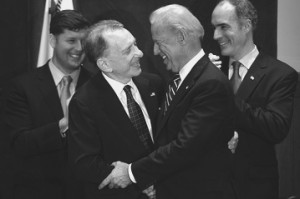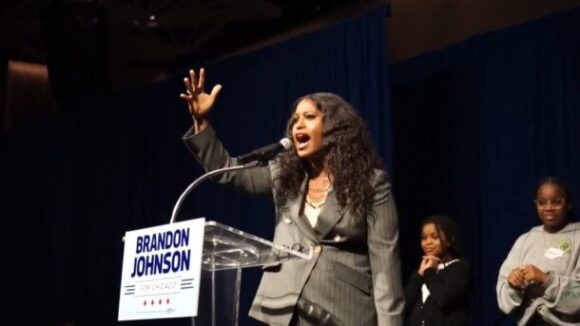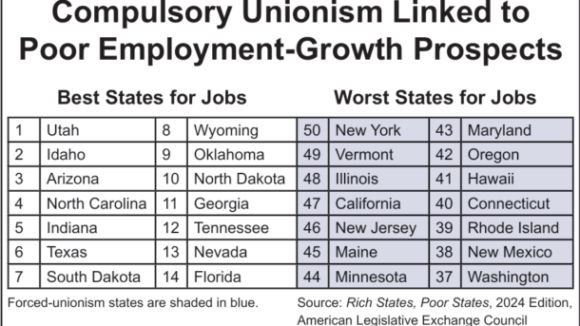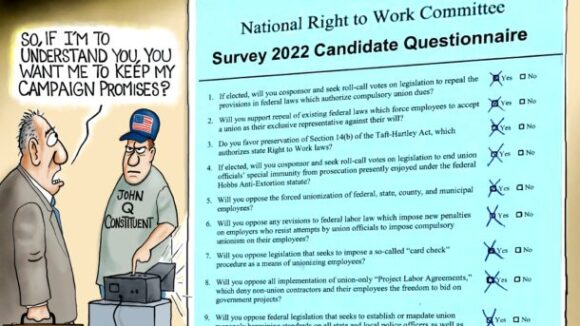Is This Any Way to Run a City’s Schools?
Leaked CTU Proposals Won’t Do Anything to Improve Schools’ Poor Performance
Pro-Forced Unionism Federal Candidates Will Have Nowhere to Hide
Federal reports show that, in 2007 and 2008, Big Labor PACs directly contributed $73 million to federal candidates.  And Big Labor-operated Section 527 groups spent an additional $57 million on an array of get-out-the-vote efforts for pro-forced unionism candidates.
And Big Labor-operated Section 527 groups spent an additional $57 million on an array of get-out-the-vote efforts for pro-forced unionism candidates.
These two types of political spending officially acknowledged by union bosses add up to $130 million in the 2007-2008 campaign cycle. That’s no mean sum.
But Big Labor’s officially acknowledged campaign expenditures represent only the tip of the iceberg of union electioneering, as union insiders like Jon Tasini, a former union official who now heads the New York-based Labor Research Association, have acknowledged again and again.
In a February 20, 2005 op-ed for the Los Angeles Times, Mr. Tasini reported that several “union political experts” had admitted to him that “unions spend seven to 10 times what they give candidates and [campaign organizations] on internal political mobilization.”
“Following Jon Tasini’s formula, in the 2007-2008 campaign cycle, Organized Labor spent between $900 million and $1.3 billion, mostly forced-dues money, on ‘internal political mobilization,'” noted Matthew Leen, vice president of the National Right to Work Committee.
Candidate Survey Is ‘One of the Committee’s Most Effective Tools’
“Forced-dues money pays for political phone banks, propaganda mailings, and the salaries and benefits for tens of thousands of campaign ‘volunteers,'” Mr. Leen continued.
“And the Wall Street Journal reported last month that the AFL-CIO hierarchy ‘plans to roll out its biggest political campaign ever’ in 2010.”
To meet union bigwigs’ challenge, the National Right to Work Committee has launched its federal candidate Survey 2010.
As longtime Committee members know, the federal candidate survey asks congressional candidates to commit themselves to oppose forced unionism consistently and support national Right to Work legislation if elected.
The survey is “one of the Committee’s most effective tools,” observed Mr. Leen.
“Senate and House candidates are given several chances to return their surveys and answer 100% in favor of Right to Work,” Mr. Leen explained.
“And millions of Right to Work supporters are mobilized to lobby candidates to respond to their Right to Work surveys.
“The success of the survey program is key for the Committee’s future ability to defeat Big Labor power grabs in Congress and, ultimately, pass a national Right to Work law.”
Survey Will Target Critical Senate and House Contests
The Survey 2010 will target critical Senate races in a number of states, including Pennsylvania and Arkansas, where Big Labor Democrat Sens. Arlen Specter and Blanche Lincoln, respectively, are both at significant risk of losing their seats.
The survey will encourage Sens. Specter and Lincoln to repudiate unequivocally their records of support for compulsory unionism and call upon their challengers to pledge 100% support for Right to Work if elected.
Other Senate target states include New Hampshire, Kentucky, Indiana, Ohio, North Dakota, Colorado and Nevada.
In the House, the Survey 2010 is targeting dozens of “open seat” races and races in which potentially vulnerable Big Labor allies are seeking reelection.
“Before Election Day, the citizens these politicians are vying to represent in Congress have a right to know where they stand on Right to Work,” noted Mr. Leen.
“Regardless of whether they are political newcomers or have already cast thousands of recorded votes, Big Labor candidates will have nowhere to hide this year. Candidates in both major parties will feel intense heat to support Right to Work.”
Right to Work Vice President Optimistic Members’ Support Will Continue to Intensify
“I am confident that Committee members’ intensifying support for our survey program will counterbalance the union bosses’ billion-dollar scheme and, as a result, the Right to Work cause will enjoy many important victories throughout the 2010 campaigns,” Mr. Leen continued.
He urged members across the U.S. to be on the lookout for their Survey 2010 mailings, and to send their postcards and letters to their candidates promptly once the mailings arrive.

Leaked CTU Proposals Won’t Do Anything to Improve Schools’ Poor Performance

Wherever Big Labor wields the power to collect forced union dues, union bosses funnel a large share of the confiscated money into efforts to elect and reelect business-bashing politicians. Employment growth tends to lag as a consequence.

Members Insist They Keep Pro-Right to Work Campaign Promises